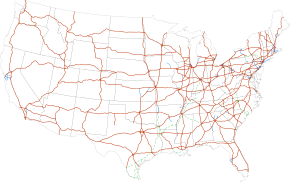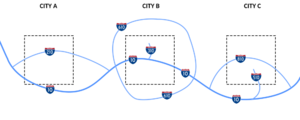List of auxiliary Interstate Highways facts for kids

Highway shield for Interstate 295
|
|

Interstate Highways in the 48 contiguous states
|
|
Quick facts for kids System information |
|
|---|---|
| Formed: | June 29, 1956 |
| Highway names | |
| Interstates: | Interstate X (I-X) |
| System links | |
Imagine the United States' Interstate Highway System as a giant network of superhighways connecting cities and states. While there are main highways, there are also special smaller roads called Auxiliary Interstate Highways. You might also hear them called three-digit Interstate Highways because their numbers always have three digits.
These auxiliary routes help connect the main highways to cities or go around them. There are three main types:
- Spur routes: These roads connect to a main Interstate at one end and usually lead into a city.
- Bypasses: These roads connect to the same main Interstate at both ends, often going around a city.
- Beltways: These roads form a complete circle around a city, connecting to the main Interstate in at least two places.
Just like the main Interstates, these auxiliary highways are built to high standards. They are designed for fast and safe travel.
The numbers for these shorter auxiliary routes are based on the main Interstate they connect to. For example, if a road connects to Interstate 95, its number will end in "95" (like I-x95).
Here's a cool trick to tell them apart:
- Spur routes usually start with an odd first digit (like I-395).
- Bypasses and beltways usually start with an even first digit (like I-695).
Sometimes, the same three-digit number can be used in different states, but it will never be repeated within the same state.
Did you know? Three states don't have any auxiliary Interstates: Alaska, Arizona, and New Mexico. North Dakota has one, but it's not officially signed with the Interstate shield. Wyoming has one that doesn't quite meet all the high Interstate standards.
Contents
Understanding Auxiliary Interstate Highways
Auxiliary Interstates are sorted into three main types: spurs, loops (which are also called beltways), and bypasses.
The first digit of the three-digit number usually tells you if the road is a bypass, spur, or beltway. The last two digits come from the main Interstate Highway it's connected to. For example, I-515 starts with a "5" (an odd number), which means it's a spur. The "15" in I-515 shows that it's a helper road for I-15.
Sometimes, the numbering rules aren't perfectly followed. This can happen if a road's path was changed, extended, or removed. Also, if there aren't enough "proper" numbers left, a different number might be used.
What is a Spur Route?
A spur route's number usually starts with an odd digit. These roads often do one of the following:
- They might go into a part of a city or a large area that the main highway doesn't reach. They often end at a regular city street or a smaller highway. An example is I-185 in Columbus, Georgia.
- They could be the first part of a highway that's planned to be longer in the future. For instance, I-540 in Arkansas was built this way.
- They might connect two different Interstate highways. For example, I-390 in New York State and I-355 in Illinois connect two separate Interstates.
States sometimes have different ways of numbering these connector roads. For example, I-390 connects two different Interstates but has an odd first digit (like a spur). But I-275 in Tennessee also connects two different Interstates but has an even first digit (like a bypass). This can even vary within the same state! In Michigan, both I-196 and I-696 connect I-96 at one end and I-94 at the other.
Here are some examples of spur routes:
- I-110 in California links I-10 to the Port of Los Angeles. This road was built before the Interstate system and was later added.
- I-180 in North-Central Pennsylvania connects Williamsport and Lycoming County to I-80. It also helps travelers get to New York and I-86.
- I-190 in New York connects Niagara Falls and Buffalo to I-90.
Sometimes, a three-digit Interstate branches off from another three-digit Interstate. These spurs don't connect directly to the main parent highway, but they are linked through the three-digit highways they do meet.
Examples include:
- I-380 in Northern California is in the San Francisco Bay Area. This highway starts at I-280 and connects to US 101 and San Francisco International Airport.
- I-190 in Massachusetts branches off from I-290 near Worcester.
- I-795 in Baltimore County, Maryland branches off from I-695.
What is a Bypass?
A bypass route usually goes around a city. Sometimes, the main highway might go through the city, and the bypass offers an alternative route around it. Typically, a three-digit Interstate bypass connects to another Interstate highway at both of its ends. Bypass routes always have an even number as their first digit.
Examples include:
- I-220 in Louisiana helps drivers go around downtown Shreveport.
- I-440 forms a loop around the south side of Nashville.
- I-890 travels through downtown Schenectady, while I-90 avoids it.
As mentioned before, some states might call a road a bypass even if it connects to two different Interstates, while others might call it a spur.
What is a Beltway?
A beltway (also known as a loop route) completely circles a major city. These roads often have many connections to other highways. Unlike other auxiliary Interstates, beltways don't have a "start" or "end" point in the usual sense. However, they do have a spot where the highway mileage count resets to zero. Beltways also have an even number as their first digit.
Some examples of beltways include:
- I-275 in Ohio, Kentucky, and Indiana circles the city of Cincinnati.
- I-465 in Indiana circles the city of Indianapolis.
- I-495 in Maryland and Virginia circles Washington, D.C. It's famously known as "The Capital Beltway."
Images for kids



